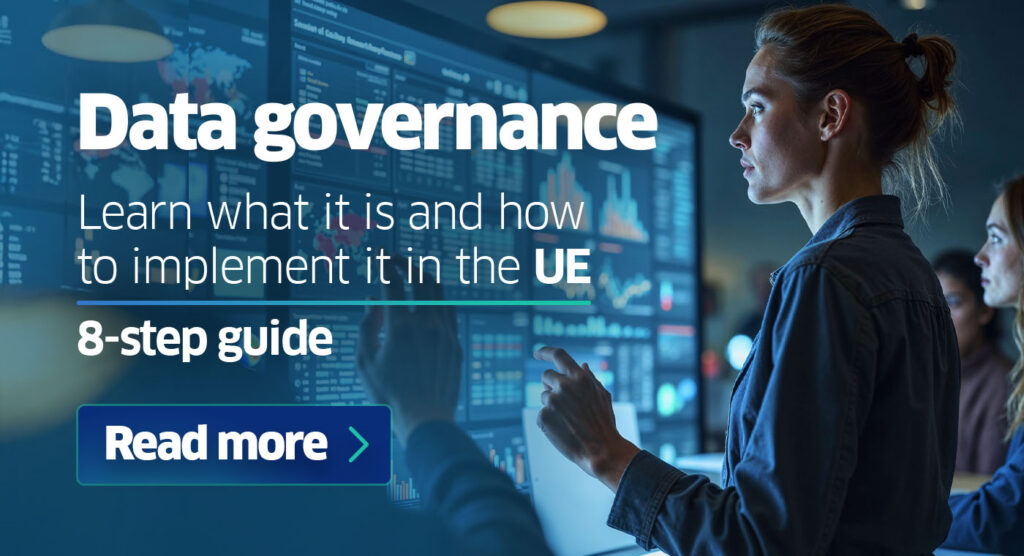Data governance is the discipline of managing corporate data as a true strategic asset through policies, roles, processes, and technologies that ensure its quality, security, availability, and legal compliance. According to tech giant IBM, it is “the data management discipline that focuses on data quality, security, and availability within an organization”.
It is considered a subset of broader data management, which covers the entire data lifecycle: collection, storage, processing, and usage.
Main objectives of data governance
- Data quality: ensuring data is accurate, complete, and consistent.
- Security and regulatory compliance: protecting sensitive data in compliance with GDPR and sector-specific regulations (e.g., HIPAA, SOX).
- Controlled accessibility: making sure the right data is available at the right time.
Table of contents
What does data governance mean?
According to AWS, data governance is a practice that enables organizations to make informed decisions, ultimately enhancing their competitive advantage.
The concept involves at least two key roles:
- data owner – the person responsible for the data.
- data steward – the person in charge of the day-to-day operational management.
In essence, governance covers models, standards, metrics, tools, and procedures, defining who can use what and how.
How to implement data governance in your organization
Starting a corporate data governance program means embarking on a structured journey, divided into clear steps—from planning and continuous monitoring to long-term improvement. Let’s walk through them one by one:
1. Define your objectives
The first step is understanding why you want to launch a data governance initiative. Begin by identifying expected outcomes—such as improving data quality, ensuring regulatory compliance, or optimizing information access—and align them with your organization’s real business needs.
2. Engage stakeholders and assign roles
Stakeholder involvement is crucial. An executive sponsor can help secure visibility and resources. At the same time, a governance committee defines key roles like the previously mentioned data owners and data stewards.
3. Map data assets and assess current state
This phase involves creating a data inventory: What sources are in use? Where is the data stored? Who owns it? How is it used? Key aspects to evaluate include data quality, completeness, and security.
4. Draft policies, standards, and frameworks
This is where regulatory structure comes into play—covering laws, rules, quality metrics, access, privacy, retention, ethical usage, and protection. A clear, consistent, and repeatable model should be designed and adopted across the entire organization.
5. Deploy tools and technologies
To operationalize the governance framework, you’ll need the right technologies: data catalogs, data management systems, data lineage tools, and monitoring platforms for quality and compliance.
6. Monitor, measure, and report
Once implemented, the system must be continually monitored. Define strategic KPIs, such as the percentage of compliant data or information flow efficiency. Collect user feedback to assess policy effectiveness and drive improvement.
7. Build culture, training, and continuous improvement
Governance isn’t just about tools—it’s also about people. Invest in ongoing training programs and promote a mindset open to iteration and change, so that governance becomes part of your organizational culture.
8. Iterate and evolve with agility
This is a cyclical process. Each iteration produces new insights, which may require updating tools, processes, or policies. An agile approach enables rapid adaptation to evolving needs, regulations, and technologies.
By following these structured steps, data governance becomes more than a static checklist—it becomes a dynamic, integrated process. Each step builds upon the last, reinforcing a continuous and increasingly resilient governance model.
Real-world examples
- IBM Cloud Pak for Data enables cataloging, profiling, and automation to enhance data quality, security, and compliance.
- On AWS, data governance includes features such as AWS Lake Formation, which allows organizations to define roles, access controls, and data lineage.
- Companies in the healthcare and energy sectors use governance frameworks to support big data, AI, and IoT initiatives. For instance, in hospitals, data governance is essential for handling sensitive patient information securely and in compliance with regulations.
What is the Data Governance Act (DGA)?
The Data Governance Act (DGA) is a European regulation (Regulation EU 2022/868), adopted by the European Parliament on May 30, 2022, entered into force on June 23, 2022, and became applicable on September 24, 2023.
Objectives and Pillars of the DGA
- Reuse of public and protected data: Enables secure reuse of non-open public sector data (e.g., health or environmental data).
- Regulated data intermediaries: Neutral entities that facilitate trusted data exchange between public and private organizations.
- Data altruism: Citizens and businesses voluntarily donate their data for general interest purposes, such as scientific research.
This regulation aims to strengthen trust in data sharing, promote interoperability, and foster the creation of “common European data spaces” in strategic sectors such as healthcare, environment, energy, mobility, manufacturing, and public administration.
Why is data governance important?
As highlighted by Digital4, data governance is not just a technical issue—it’s a strategic driver of digital transformation. It helps reduce data management costs, enhances transparency, and enables organizations to fully leverage their data potential.
Moreover, with regulations like the Data Governance Act (DGA) and the GDPR, compliance is no longer optional—it’s essential to avoid penalties and build trust with customers.
Develop your European data governance project. Choose PMF Research
Since 2003, PMF Research has been an internationally recognized research and development (R&D) center in Information and Communication Technologies (ICT). Our core areas include augmented reality (AR), virtual reality (VR), artificial intelligence (AI), and big data.
If your organization is looking to:
- launch European data governance projects;
- integrate technologies to ensure DGA/GDPR compliance;
- participate in common European data spaces;
Now is the time to partner with us. We specialize in EU funding and can support you in crafting high-quality proposals to unlock the value of data across Europe.
Get in touch
- Phone: +39 095 7225331
- Contact form: Scroll to the bottom of the page and fill it out to send us an email.
Together, we can build strategic partnerships that make data governance a success.




